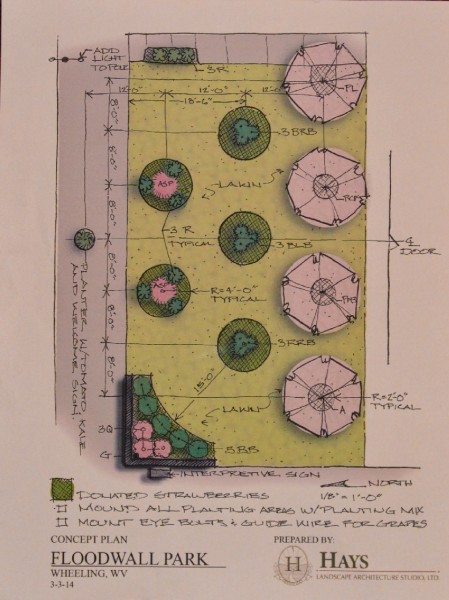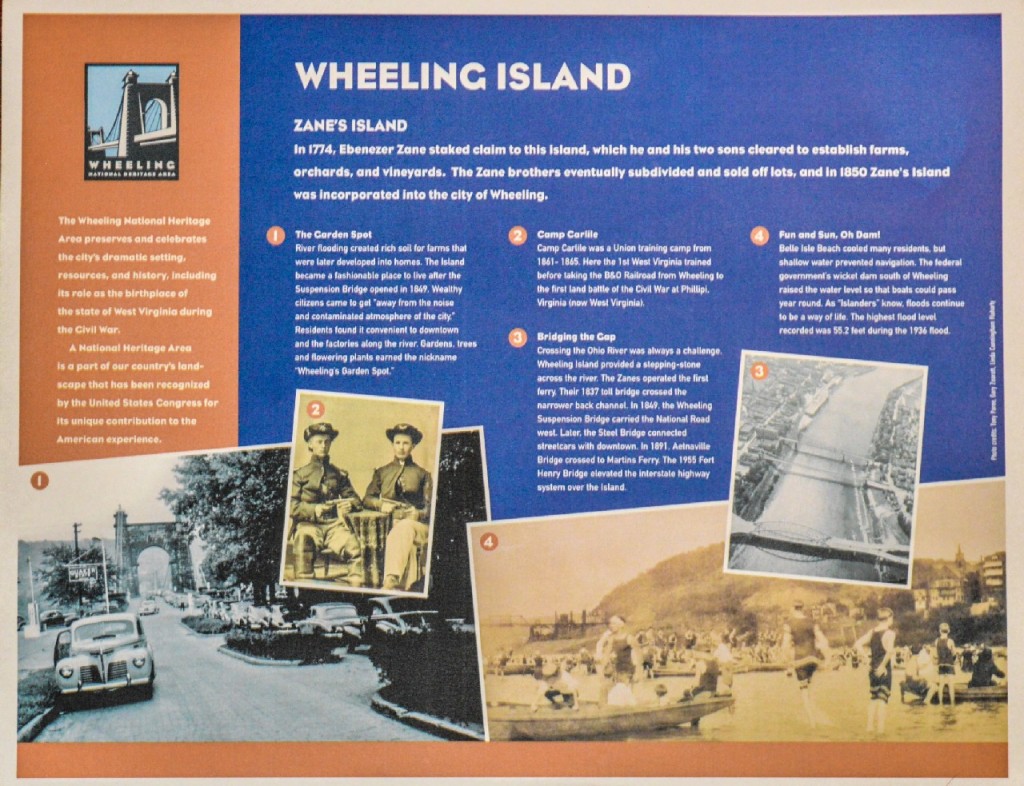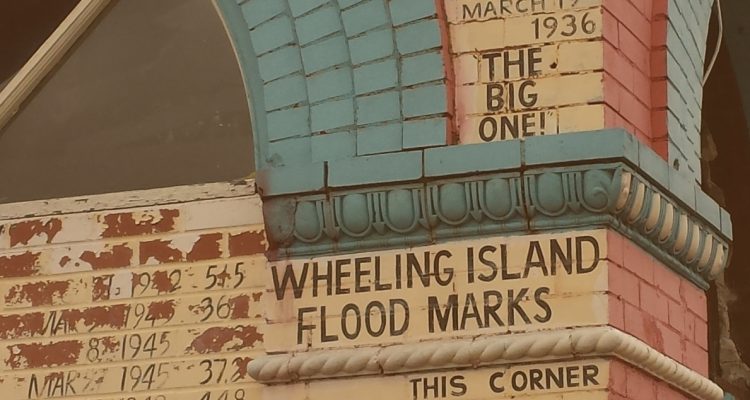By Steve Novotney
Weelunk.com
For decades Wheeling’s residents and visitors have traveled past the history of the Friendly City’s flooding events, and despite the razing of the former Gene Long Community Center on Wheeling Island, that historical display will remain intact thanks to the Wheeling National Heritage Area Corp. and the city of Wheeling.
According to Jeremy Morris, the price tag for the Floodwall Park is higher than initially projected – $80,000 – but the preservation of this wall was of paramount importance to many Wheeling Island residents, as well as local historians.
“There was a public outcry from a lot of people who recognized the historical significance of the wall, and that made all the difference to the city of Wheeling,” explained Morris. “Preserving this wall and the historical flood mark is right up the alley of what our organization tries to do.
“The mission of WNHAC is to preserve as much of Wheeling history and heritage as possible, and a lot of people made it very clear that this wall was part of both on Wheeling Island,” he said. “The first recorded flood on the wall is from 1780, so flooding has been a big part of the history of Wheeling Island. Even today, the possibility drives a way of life. They all have their plans in place, and they handle it. That makes it a point of pride for those residents.”
The funding for the Floodwall Park, located on the corner of Virginia and South Penn streets, flowed from a National Park Service grant. Much of the expense involved the preservation of the brick wall itself. The building, home to several different pharmacies, meat markets, and convenience stores, was constructed in 1890.
“The building was not in good shape when the demolition took place, so there had to be a lot of work performed on that section to make sure it would continue standing for years to come,” he said. “That was a lot of work, and it was more expensive than what was anticipated because you really don’t know until the construction folks start the work.
“There was a lot of soft brick and a lot of soft mortar, and Walters Construction did an excellent job working with some very difficult issues,” he continued. “The city of Wheeling deserves credit, too, because when the demolition took place last February, the crews had to be very careful to leave as much as they could. And they did that.”

The Floodwall Park will be surrounded by a new, green-space area that will feature fruit-bearing trees in spring 2015. The “edible park,” Morris said, is currently a trend in many cities across the country, including Seattle, where a seven-acre facility recently opened.
“I think it’s part of this food movement we have seen take hold here in Wheeling and all over the United States,” Morris said. “People want food security. I think a lot of people are tired of having no idea where their food comes from or what they are sprayed with.
“We’ve had too many food alerts the past few years, and I know I want to know who’s handling my food and how it’s processed, but a park like this one will let a visitor pick their own and enjoy the area.”
Four trees – pear, apple, plum, and peach – will line the south side of the park, and raspberries, strawberries, asparagus, and other fruits and vegetables will fill the center-based mounds. WNHAC will also erect an interpretive sign that offers the history of Wheeling Island.
“Wheeling Island is really the only place we can do something like this park because of the deer population we have everywhere else but here,” Morris said. “And I have spoken with the folks with the Wheeling Island Association and the Wheeling Island Gardeners Club, and they all seem very excited.”

Gene Long purchased the building in 1979, and soon repainted it and added the flood-level recordings. Originally red, white, and blue, the paint faded over the years. At the time of the demo, the exterior walls appeared pink, prompting complaints from neighbors.
The wall has been repainted as a part of the preservation plan, and the color used was, “raspberry truffle.”
“We worked with PPG Paints to match the original color as closely as we could from the photographs we had,” Morris said. “The two sides of the wall will not be painted at all because we want to offer the visitors the visible difference between the preserved wall and the original wall.”
Local artist Patricia Croft was commissioned by WNHAC to reproduce the legendary recordings. While she worked, Croft reported, many people honked, stopped by to speak with her about the project, and photographed her at work.
“I painted the flood wall for a few hours on Sunday, and then all day on Monday, Tuesday, and Wednesday. Throughout each day, people would drive by and honk, say, ‘you’re doing a great job,’ or, ‘thank you for doing that,’” she explained. “Some people would stop and get out of their car and indulge me with stories of the flood their dad lived through or their grandfather endured. Other neighborhood folks walking by would stop and tell me how they used to deliver pharmaceuticals to this building when it was a pharmacy, or how they remember when there was an ice cream counter serving Kirk’s ice cream.
“I even had a guy (Tony Horwitz) from the Smithsonian Magazine stop and talk to me, take a few pictures, and jot down some notes,” she said. “He, too, was intrigued by the old buildings and history.”

Croft will continue restoring the flood recording as weather permits, but the Floodwall Park will not be completely landscaped and planted until spring 2015. The names of all the businesses that operated in the building will be listed on the restored wall as well, along with the years of operation.
“When we look at the area, we decided we didn’t just want a green space where the Gene Long building stood, so we decided to do something that’s never been done in this area,” Morris said. “And this project preserves another piece of history within an area with a tremendous amount of Wheeling history surrounding it.
“It was the right thing to do, and that’s why WNHAC and the city preserved it,” he added. “And there will be new recordings, but history tells us that this area experiences flooding, and Wheeling Island always takes the brunt of it.”





